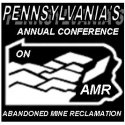
EPCAMR Staff feels this is the most extensive recount of coal mining impact on those who live in and work in the coal region by a newspaper investigation. Thank you, Scranton Times, for working with us!
Investigation Navigation
________________________________________
Part 1 – 1/30/2005
Too Many Mines, Too Little Money
State Program Trying To Make Up for Lost Federal Contributions
Part 2 – 1/31/2005
Danger Lurks in Mines
Part 3 – 2/1/2005
Mining for Solutions
Competing Plans
Successful Reclamation Results are All Around
Orange Water, Silver Lining
________________________________________
Orange Water, Silver Lining
BY JESSICA D. MATTHEWS TRIBUNE STAFF WRITER 2/01/2005

Robert Hughes, regional coordinator of Eastern PA Coalition for Abandoned Mine Reclamation, takes water samples in a mine drainage near Nanticoke. (Michael J. Mullen)
Crouching in the marsh, Robert Hughes scoops large test tubes in the orange water of a 20-acre acid mine drainage pit in Newport Township.
The Luzerne County pit, called Newport Lake by locals, has been sitting on a federal abandoned mine inventory list for more than a decade waiting for money to be freed up for its reclamation.
It is estimated to cost more than $1 million to reclaim the site. It is one of 2,075 abandoned mine sites in Pennsylvania that need to be cleaned up and one of 211 in Luzerne.
The pit is considered a lower-priority project because the state determined it does not pose a threat to public safety or health. It will most likely be among the last projects cleaned up in Luzerne County.
The pit, however, is close to a cemetery where many people visit and could pose health risks to them, said Mr. Hughes, regional coordinator for the Eastern Pennsylvania Coalition for Abandoned Mine Reclamation.
In an attempt to get the pit cleaned up faster without relying on federal dollars, Mr. Hughes collects water samples that will be tested for iron oxide deposits at a lab in Pittsburgh. He hopes the iron oxide and other metals recycled from acid mine drainage will become a new source of raw materials.

Laura Boone, 15, Nanticoke High School student, helps with iron samples in a mine drainage project near Nanticoke. She will use the samples in a Junior Academy of Science presentation. (Michael J. Mullen)
If high percentages of iron oxide are found, there is the potential to market the site to companies that will harvest the mineral, he said.
When processed, the iron oxide can be used in paint, wood stains, wood chips, concrete, landscaping mulch, even tattoo ink. The iron oxide has a market value of $100 to $300 a ton.
“We’re trying to help open those doors to these markets,” he said.
The coalition is testing other acid mine drainage pits throughout Northeastern Pennsylvania. To date, it has collected more than 85 water samples.
Once analyses are complete, the coalition will create a map of the tested sites with their results, Mr. Hughes said. The maps can then be presented to companies to see if they are interested in buying the rights to harvest the iron oxide. The orange color that acid mine drainage water turns is an indicator of iron oxide being present, Mr. Hughes said.
Pennsylvania has the largest acid mine drainage problem in the nation, said state Department of Environmental Protection Secretary Kathleen A. McGinty. Statewide, more than 2,800 miles of waterways are polluted with such drainage. Many discharges go untreated for lack of funding.
Pennsylvania spends more than $12 million a year treating 23 billion gallons of acid mine drainage from these coal mines, she said. Making iron oxide commercially viable would help reduce the cost to cleanup sites, she said.
One environmental consulting firm, Hedin Environmental, of Pittsburgh, has already collected 1,500 tons of iron oxide from four Western Pennsylvania acid mine drainage sites for Hoover Color Corp, of Virginia. Hoover Color produces earth-tone pigments for building products from the iron oxide.
Success stories like Hedin Environmental could prompt companies to become prospectors, Mrs. McGinty said. The companies would harvest the iron oxide from Pennsylvania’s acid mine drainage waters instead of environmental groups and clean up the sites, she said.
©Scranton Times Tribune 2005












You must be logged in to post a comment.